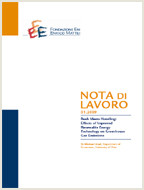Regional Low-Emission Pathways from Global Models

26.11.2015
Heleen van Soest (PBL Netherlands Environmental Assessment Agency); Lara Aleluia Reis (Centro Euro-Mediterraneo sui Cambiamenti Climatici CMCC, Fondazione Eni Enrico Mattei); Detlef van Vuuren (PBL Netherlands Environmental Assessment Agency); Christoph Bertram (Potsdam-Institut für Klimafolgenforschung PIK); Laurent Drouet (Centro Euro-Mediterraneo sui Cambiamenti Climatici CMCC, Fondazione Eni Enrico Mattei); Jessica Jewell (International Institute for Applied Systems Analysis IIASA); Elmar Kriegler (Potsdam-Institut für Klimafolgenforschung PIK); Gunnar Luderer (Potsdam-Institut für Klimafolgenforschung PIK); Keywan Riahi (International Institute for Applied Systems Analysis IIASA); Joeri Rogelj (International Institute for Applied Systems Analysis IIASA); Massimo Tavoni (Centro Euro-Mediterraneo sui Cambiamenti Climatici CMCC, Fondazione Eni Enrico Mattei, Politecnico di Milano); Michel den Elzen (PBL Netherlands Environmental Assessment Agency); Aayushi Awasthy (The Energy and Resources Institute TERI); Katherine Calvin (Pacific Northwest National Laboratory PNNL); Pantelis Capros (Institute of Communication and Computer Systems ICCS); Leon Clarke (Pacific Northwest National Laboratory PNNL); Michel Colombier (Institut du Développement Durable et des Relations Internationales IDDRI); Teng Fei (Tsinghua University TU); Amit Garg (Indian Institute of Management Ahmedabad IIMA); Fernanda Guedes (The Alberto Luiz Coimbra Institute for Graduate Studies and Research, Federal University of Rio de Janeiro COPPE/UFRJ); Mariana Imperio (The Alberto Luiz Coimbra Institute for Graduate Studies and Research, Federal University of Rio de Janeiro COPPE/UFRJ); Mikiko Kainuma (National Institute for Environmental Studies NIES); Jiang Kejun (Energy Research Institute of NDRC ERI); Alexandre C. Köberle (The Alberto Luiz Coimbra Institute for Graduate Studies and Research, Federal University of Rio de Janeiro COPPE/UFRJ); Peter Kolp (International Institute for Applied Systems Analysis IIASA); Volker Krey (International Institute for Applied Systems Analysis IIASA); Alban Kitous (European Commission, DG Joint Research Centre JRC); Paroussos Leonidas (Energy – Economy – Environment Modelling Laboratory E3M Lab); Andre Lucena (The Alberto Luiz Coimbra Institute for Graduate Studies and Research, Federal University of Rio de Janeiro COPPE/UFRJ); Toshihiko Masui (National Institute for Environmental Studies NIES); Larissa Nogueira (The Alberto Luiz Coimbra Institute for Graduate Studies and Research, Federal University of Rio de Janeiro COPPE/UFRJ); Roberta Pierfederici (Institut du Développement Durable et des Relations Internationales IDDRI); Bert Saveyn (European Commission, DG Joint Research Centre JRC);Roberto Schaeffer (The Alberto Luiz Coimbra Institute for Graduate Studies and Research, Federal University of Rio de Janeiro COPPE/UFRJ); Fu Sha (Renmin University and National Centre for Climate Change Strategy and International Cooperation); Bianka Shoai (Research Institute of Innovative Technology for the Earth RITE); P.R. Shukla (Indian Institute of Management Ahmedabad IIMA); Thomas Spencer (Institut du Développement Durable et des Relations Internationales IDDRI); Alexandre Szklo (The Alberto Luiz Coimbra Institute for Graduate Studies and Research, Federal University of Rio de Janeiro COPPE/UFRJ); Henri Waisman (Institut du Développement Durable et des Relations Internationales IDDRI)
Q54
Climate Policy, Mitigation, Global and National Policy Comparison
Climate Change and Sustainable Development
Carlo Carraro
Governments worldwide have agreed that international climate policy should aim to limit the increase of global mean temperature to less than 2oC with respect to pre-industrial levels. The purpose of this paper is to analyse the emission reductions and related energy system changes in various countries in pathways consistent with the 2oC target. We synthesize and provide an overview of the national and regional information contained in different scenarios from various global models published over the last few years, as well as yet unpublished scenarios submitted by modelling teams participating in the MILES project (Modelling and Informing Low-Emission Strategies). We find that emissions in the mitigation scenarios are significantly reduced in all regions compared to the baseline without climate policies. The regional cumulative CO2 emissions show on average a 76% reduction between the baseline and 450 scenario. The 450 scenarios show a reduction of primary energy demand in all countries of roughly 30-40% compared to the baseline. In the baseline scenario, the contribution of low-carbon energy technology remains around 15%, i.e. similar as today. In the mitigation scenario, these numbers are scaled up rapidly towards 2050. Looking at air quality, sulphur dioxide and black carbon emissions are strongly reduced as a co-benefit of greenhouse gas emission reductions, in both developing and developed countries. However, black carbon emissions increase in countries that strongly rely on bioenergy to reach mitigation targets. Concerning energy security, energy importing countries generally experience a decrease in net-energy imports in mitigation scenarios compared to the baseline development, while energy exporters experience a loss of energy export revenues.
***
Suggested citation: van Soest, H., L. Aleluia Reis, D. van Vuuren, C. Bertram, L. Drouet, J. Jewell, E. Kriegler, G. Luderer, K. Riahi, J. Rogelj, M. Tavoni, M. den Elzen, A. Awasthy, K. Calvin, P. Capros, L. Clarke, M. Colombier, T. Fei, A. Garg, F. Guedes, M. Imperio, M. Kainuma, J. Kejun, A. C. Köberle, P. Kolp, V. Krey, A. Kitous, P. Leonidas, A. Lucena, T. Masui, L. Nogueira, R. Pierfederici, B. Saveyn, R. Schaeffer, F. Sha, B. Shoai, P. R. Shukla, T. Spencer, A. Szklo, H. Waisman, (2015), ‘Regional Low-Emission Pathways from Global Models’, Nota di Lavoro 110.2015, Milan, Italy: Fondazione Eni Enrico Mattei
